Physical Address
304 North Cardinal St.
Dorchester Center, MA 02124
Physical Address
304 North Cardinal St.
Dorchester Center, MA 02124
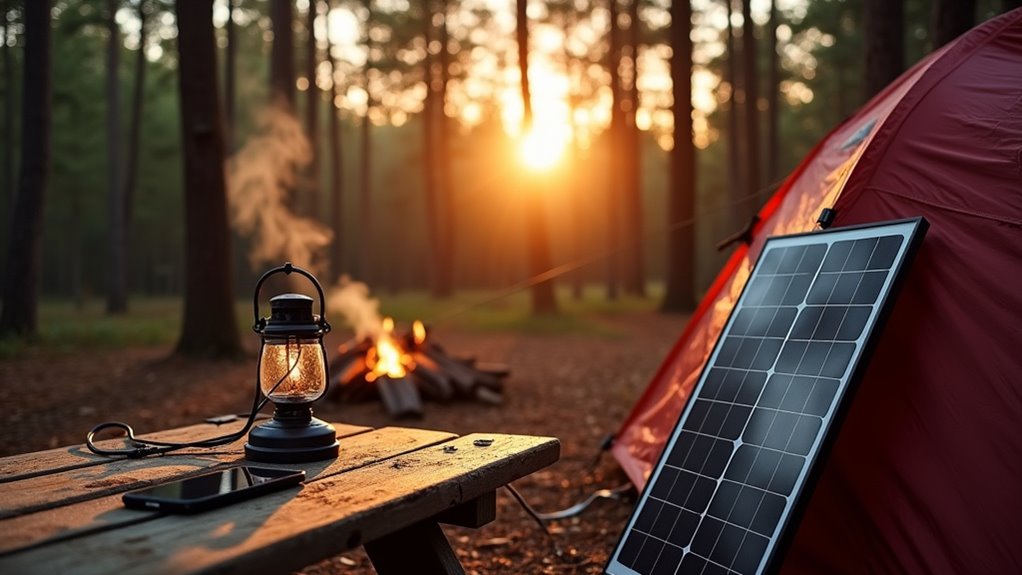
Wondering how to keep your devices charged while camping off-grid? Discover the game-changing benefits of portable solar power solutions.
You’ll find that camping with solar power opens up a world of possibilities for your outdoor adventures. By incorporating portable solar technology into your camping setup, you can enjoy modern conveniences while staying true to nature’s rhythms. From charging essential devices to powering small appliances, solar energy transforms your campsite into an eco-friendly basecamp. Whether you’re a weekend warrior or seasoned backpacker, understanding how to harness the sun’s power will revolutionize your outdoor experience.
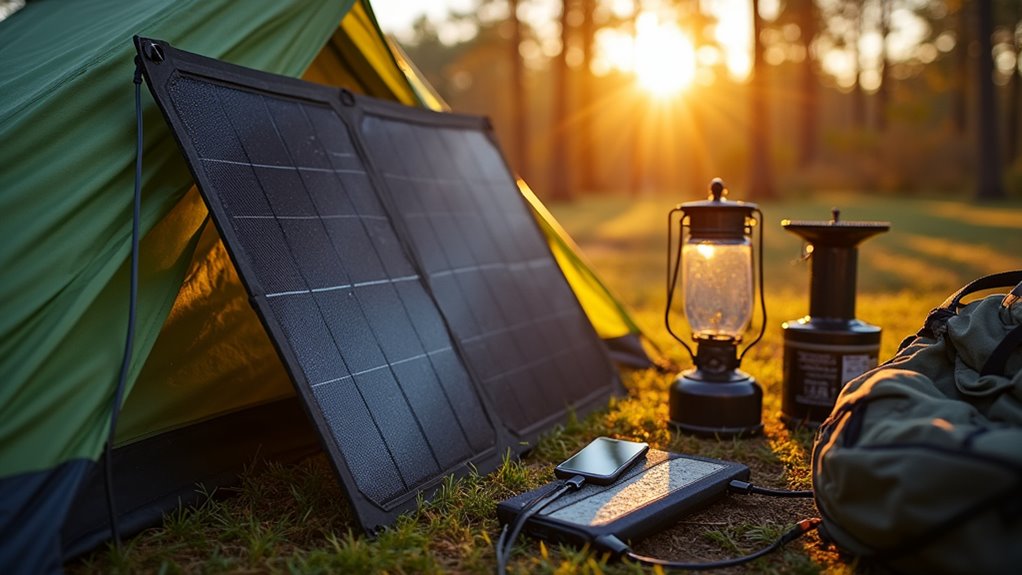
While traditional camping often means disconnecting from modern conveniences, solar power technology now bridges the gap between wilderness adventure and essential electronics.
You’ll find that portable solar panels, ranging from 10 to 200 watts, efficiently convert sunlight into usable DC power through photovoltaic cells. Harnessing solar power can provide an eco-friendly solution for your outdoor excursions.
To make the most of your solar setup, you’ll need three key components: panels to capture sunlight, a charge controller to regulate power flow, and batteries to store energy for later use. This approach promotes sustainable camping practices while letting you enjoy the comforts of modern technology.
The charge controller prevents battery damage, while an inverter transforms DC power into AC electricity for your devices. This system lets you power everything from phones to LED lights, even when the sun isn’t shining.
Solar camping setups protect your batteries and convert power efficiently, keeping your devices charged throughout your outdoor adventure.
Best of all, once you’ve invested in the equipment, you’re harnessing free energy from nature.
Now that you understand how solar power works, let’s focus on the specific gear you’ll need for your outdoor adventure.
Start with a 100-watt portable solar panel – monocrystalline panels offer the best efficiency, while flexible ones provide better durability for rugged conditions. The Jackery SolarSaga 100 consistently outperforms other models with its superior charging speeds in both sunny and cloudy conditions.
You’ll want a solar generator with a deep-cycle battery to store power for nighttime use or cloudy days. Make sure it includes an inverter to convert DC power into AC power for your devices.
Don’t forget essential accessories like power banks for backup charging, compatible cables, and protective cases for your equipment.
To maximize your setup’s efficiency, you’ll need to monitor your daily power usage and optimize panel placement.
Consider investing in solar-powered lights and fans to enhance your camping comfort without draining your main power supply. Camping generators can provide a reliable backup power source in case of low solar conditions.
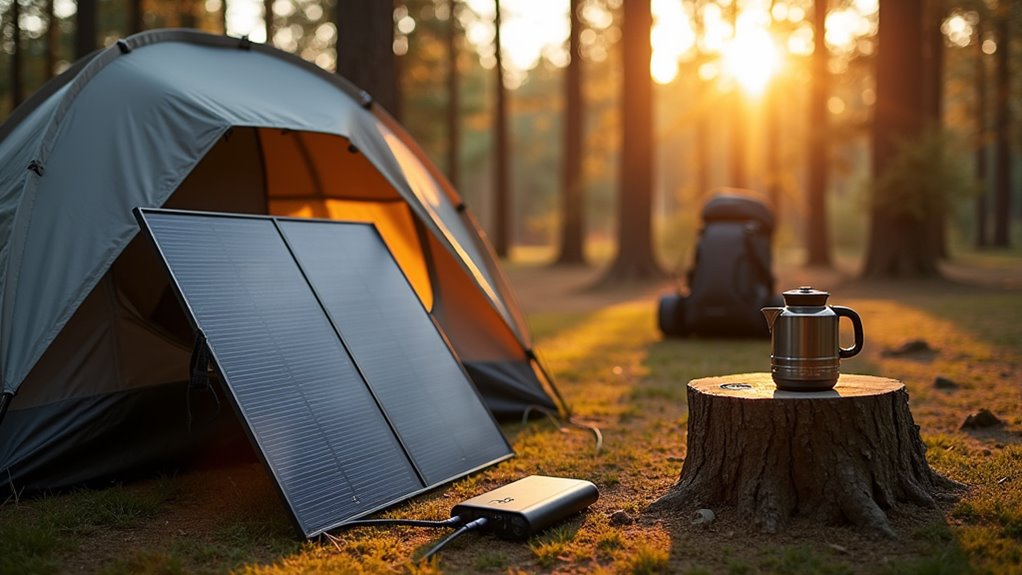
Choosing the perfect solar panel system for your camping adventures depends on balancing power needs, portability, and budget constraints.
If you’re seeking maximum efficiency, monocrystalline panels offer up to 25.4% efficiency, though they’ll cost more at $2.50-$3.00 per watt. For budget-conscious campers, polycrystalline panels provide a more affordable option with decent 17% efficiency rates. A reliable charge controller is essential to prevent battery damage and ensure optimal charging performance.
Consider your power requirements carefully – camping setups typically need between 10W to 200W. You’ll want to factor in available space and mounting options too.
For traditional camping, portable or foldable panels like the BLUETTI PV200 offer excellent flexibility. If you’re in an RV, permanent roof installations might work better.
Don’t forget to check the panel’s durability features, like ETFE coating, to guarantee it’ll withstand outdoor conditions during your adventures.
The success of your solar-powered camping setup hinges on strategic panel placement and smart energy management. Position your panels facing south in the northern hemisphere (or north if you’re camping down under) at an angle matching your latitude. You’ll capture maximum sunlight by keeping panels away from tent, tree, or vehicle shadows.
Strategic panel placement is crucial – face south in the northern hemisphere, match your latitude angle, and avoid shade for optimal solar power.
For peak power generation, reposition your panels throughout the day to follow the sun’s path. Consider using adjustable mounting kits or setting up multiple panels facing east and west. Qualified solar contractors can help ensure optimal panel positioning and system design.
Keep your panels clean from dust, leaves, and debris that can block sunlight. When possible, combine your solar setup with portable power banks to store excess energy for nighttime or cloudy conditions.
Using an MPPT charge controller will boost your system’s efficiency, ensuring you get the most from every ray of sunshine.
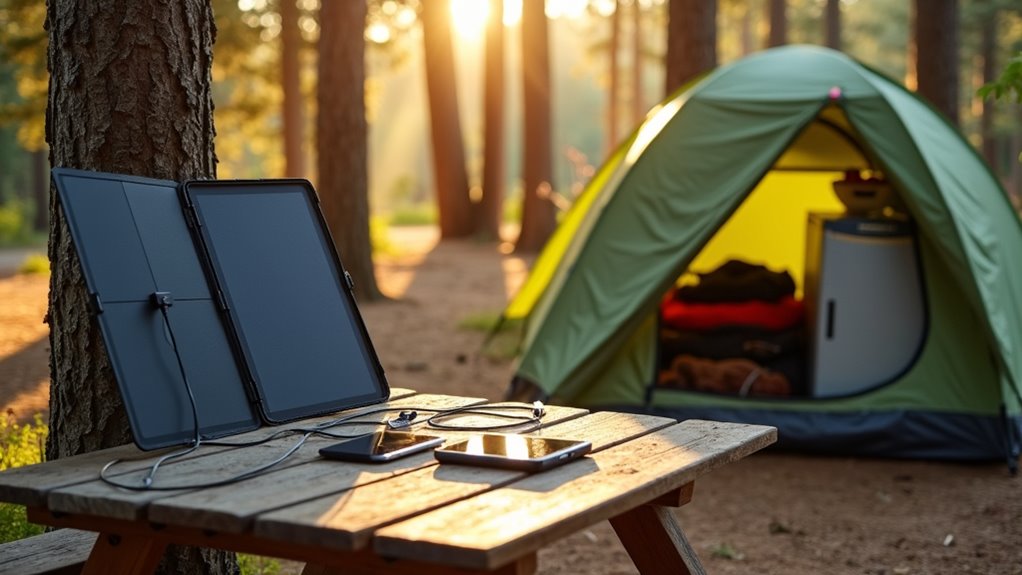
While camping off-grid, you’ll need different solar solutions for various devices, from simple phone chargers to power-hungry portable fridges.
For your phone and small electronics, a compact 5-25 watt portable solar charger with USB ports will do the job, though charging may take several hours. The chargers use photovoltaic cells to convert sunlight into usable electricity for your devices.
Portable fridges demand more substantial power. You should invest in a 100+ watt solar panel system with a reliable battery bank and charge controller to maintain consistent cooling, especially overnight. These setups are heavier but essential for food preservation during longer trips.
When selecting your solar gear, match the power output to your needs. A phone charger won’t run your fridge, and lugging around a large solar array for just charging phones isn’t practical. Boat camping is an excellent opportunity to utilize solar power for your essential equipment.
Consider multi-port options to charge several devices simultaneously, and always prioritize powering essential equipment first.
Smart battery management transforms how you power your camping setup, taking solar energy usage to the next level. With a Battery Management System (BMS), you’ll maximize every bit of solar power while protecting your investment in batteries and devices.
Your BMS works tirelessly to monitor battery health, showing you real-time charge levels and estimated run times. The advanced 30 amp charging capability ensures your batteries are replenished quickly and efficiently. It’ll automatically switch between power sources, prioritizing free solar energy before tapping into your vehicle’s power.
Modern BMS technology keeps your batteries healthy while intelligently managing power sources, ensuring you always use solar energy first.
You won’t need to worry about damaging your batteries – the system prevents overcharging, overdischarging, and monitors temperature to extend battery life. Weird camping trends can add an extra layer of adventure to your outdoor experiences.
For extended trips, you’ll appreciate the remote monitoring capabilities and customizable settings. Track your power consumption, get alerts before issues arise, and rest easy knowing your camping setup is running at peak efficiency.
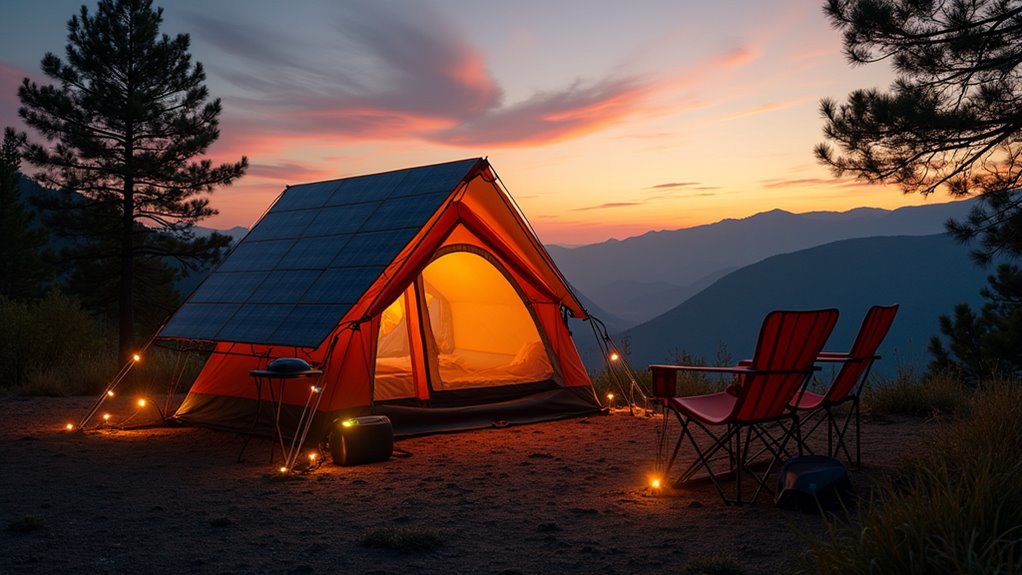
Whether you’re camping in scorching deserts or snowy mountains, modern solar solutions keep your power flowing year-round.
Today’s panels feature IP65-IP68 ratings, making them virtually impervious to rain, snow, and dust while maintaining performance in extreme temperatures.
RV camping is a way to experience nature with the amenities of home.
You’ll get the best results from monocrystalline panels, which excel in low-light winter conditions.
Position them with adjustable mounts to capture prime sunlight as seasons change, and consider using reflective ground mats to boost energy collection. Popular models like the Nature Power 110-watt provide reliable performance in varied weather conditions.
For snowy conditions, choose panels with smooth, angled surfaces that shed snow naturally.
Don’t forget to pack a portable power station to store excess energy from sunny periods.
With foldable, waterproof designs and multiple USB outputs, including USB-C, you’ll keep your devices charged through unexpected weather changes and seasonal variations.
Now that your solar setup can handle any weather, let’s put that power to work in your camp kitchen.
Start by positioning your shelter downwind from sleeping areas and setting up your panels where they’ll catch maximum sunlight. You’ll want a flat, stable surface for your cooking station with easy access to power, water, and food storage. Mastering the art of camp cooking is essential for a successful outdoor adventure.
Connect your solar panels to a charge controller and battery system, ensuring you’ve got proper circuit protection in place.
Choose energy-efficient appliances that won’t strain your 3kW setup – a typical system can generate about 12kWh daily. Keep your propane stove handy as backup, and organize your workspace with essential utensils within reach. Consider adding a two-burner stove for maximum cooking flexibility while car camping.
Remember to maintain a clean station using biodegradable soap and minimal water, and always pack out what you pack in.
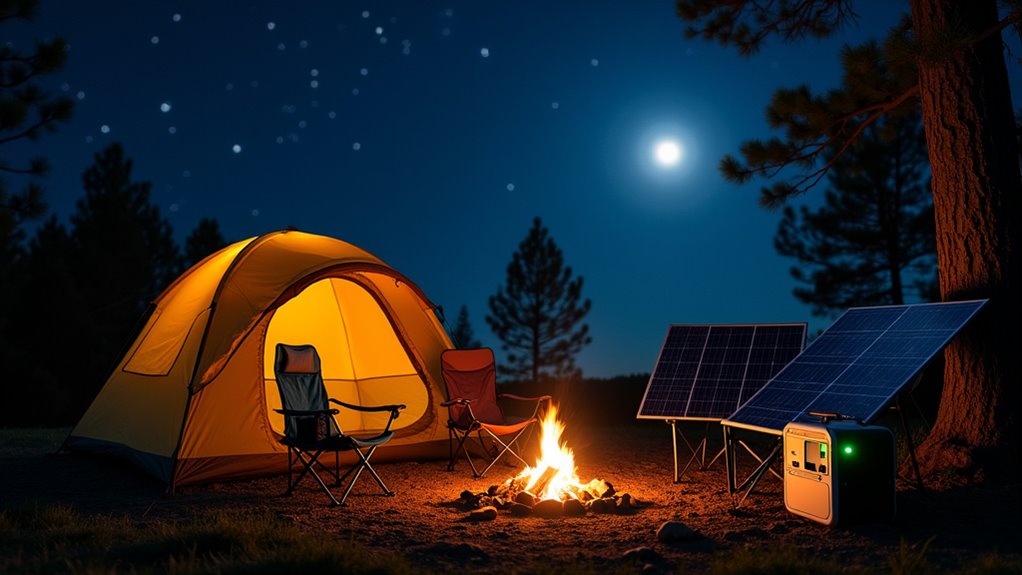
Since sunlight isn’t available after dark, effective nighttime power management becomes essential for your camping comfort and safety. Your solar setup needs reliable energy storage systems to keep your devices running through the night.
Reliable energy storage and smart power management transform solar setups into 24-hour power solutions for safer, more comfortable camping experiences.
Modern lithium-ion batteries and portable solar generators offer efficient solutions for your nighttime power needs. The Anker Solex X1 system can maintain stable power in extreme temperatures, making it ideal for outdoor adventures.
For successful nighttime power management, focus on these key elements:
Helpful tips for camping without electricity can also help you optimize your nighttime power usage and extend the runtime of your solar-powered system.
Remember to charge your storage systems fully during peak sunlight hours, and consider stackable batteries if you need extra capacity for energy-hungry appliances like portable fridges or air conditioners.
As outdoor enthusiasts embrace sustainable practices, renewable energy has revolutionized the camping experience. You’ll find that solar panels, wind turbines, and hydropower options now offer clean, reliable alternatives to traditional gas generators.
By choosing portable solar panels and compact generators, you’re not only reducing your carbon footprint but also enjoying quieter, emission-free power during your adventures. Modern campgrounds like Timberline Campground demonstrate impressive energy generation, producing 25,000 kWh annually through solar power.
You can maximize your eco-friendly camping setup by combining renewable technologies with energy-efficient gear. LED lighting, solar-powered devices, and smart power management systems help you conserve energy while staying comfortable outdoors.
These sustainable solutions don’t just protect the environment – they’ll also save you money in the long run by eliminating fuel costs and reducing equipment maintenance. Plus, you’ll preserve the natural ambiance of your campsite without the noise and fumes of conventional generators.
You’ve mastered camping with solar power, but don’t get too smug about your eco-warrior status just yet. While you’re charging your phone to post #sustainableliving selfies, remember that true outdoor connection doesn’t require a portable espresso maker or LED disco lights. Still, you’re doing better than the generator crowd next door, who’ve turned their campsite into a mini power plant. Keep it simple, save some cash, and let the sun do its thing.